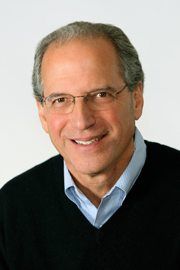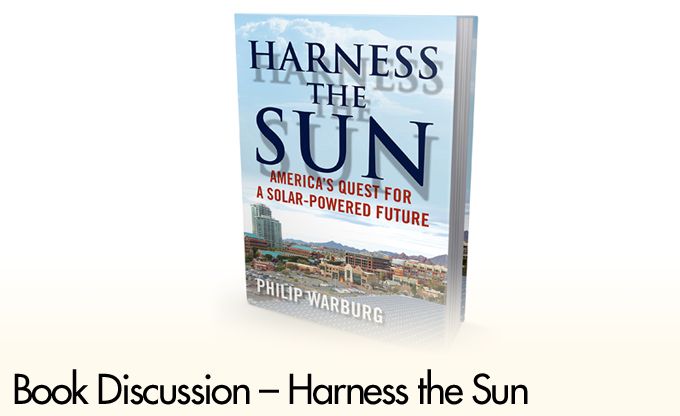For a long time, solar power was viewed as a privilege reserved for the elite. Today there are lots of ways to make solar affordable to homeowners pretty much across the income spectrum.
Philip Warburg | PhilipWarburg.com
Why did you write this book?
First and foremost, I firmly believe that we have to get serious about shifting away from fossil fuels and toward clean energy technologies if we are to save our plant from the ravages of climate change. This is the second book I’ve written about renewable energy. The first one, Harvest the Wind, looked at wind power’s dramatic ascent. This one looks at solar energy’s more recent entry into popular use and public dialogue.
When I was finishing up the book on wind, friends would ask me: “So is your next book going to be about solar? I told them: “If I ever wrote a book about solar, I’d have to call it ‘Dim Sun.’” At the time, solar struck me as too expensive to be regarded as a viable energy alternative. Boy has that changed! Today everyone from individual homeowners to utility-scale power producers are clamoring to harness the sun. During 2014, about a third of all new electric generating capacity came from solar power!
Rooftop solar panels are popping up everywhere. Can you tell us about your own experience with a rooftop solar system?
Back in the winter of 2013, my wife – an architect – and I decided the time had come to do more than talk about renewable energy. We had a couple companies come to our house to assess our solar prospects. A few months later, we had a fully operational solar system producing about three-quarters of our total power needs. And that includes charging up our plug-in electric car – a Ford C-Max, not a Tesla! – every evening.
We chose to buy the solar panels that power our home. It cost us about $17,000 after claiming the federal tax credit and state rebate. With the money we’ve saved on our electric bills since then, we’re now on track to recoup our investment within the next five years.
The White House recently announced an initiative to bring solar to low-income communities. Why is this an important issue? And did you come across any examples of groups that are already broadening access?
For a long time, solar power was viewed as a privilege reserved for the elite. Today there are lots of ways to make solar affordable to homeowners pretty much across the income spectrum. One option is to have a solar company retain ownership of the solar panels on your roof. You pay nothing upfront; all you do is pay that company for the power the solar panels generate, at an agreed-upon rate that is often cheaper than regular electricity.
But for renters or people living in multi-family housing, that doesn’t work. The White House initiative is targeting those populations, offering to install solar power on federally subsidized housing. This achieves a double benefit: it substantially lowers the electric bills of low-income households, and it substitutes clean energy for the fossil fuels that still supply most of our electric power.
It’s important to note, though, that the White House isn’t writing on a blank slate. In several states, non-profit groups have spent the past several years installing solar on low-income homes. Typically they do so using funds that states like California target at households that can’t afford solar on their own.
Google and Apple are shining examples of businesses that are investing in solar. What other types of industries are getting into the solar game, and why is it so appealing to them?
Companies like Google and Apple are setting great examples by shifting their electricity over to renewable energy. Google is literally investing billions in wind and solar projects. Walmart, IKEA, and the National Football League are also making major investments in solar.
But what’s really striking to me are the thousands of smaller companies that are opting for solar, not just for the optics, but because it’s the right thing to do from a business perspective.
Take Cardinal Shoe, a manufacturer of ballet slippers in one of my home state’s gritty industrial cities, Lowell, Massachusetts. Richard Bass, president of Cardinal Shoe, says that the power for his factory as well as all the electricity of his 27 tenants comes from the solar panels on his building’s roof. Under the agreement with the solar company that owns this solar installation, Bass pays about half as much, per kilowatt-hour, as he was paying to his local electric utility.
Climate change is still a contentious issue among political leaders. Is solar strictly embraced by progressives?
A strange thing has happened to American politics with regard to solar. On one hand, support for federal renewable energy tax incentives tends to come from the left side of the aisle. On the other hand, some of the fiercest defenders of solar power at the state level are conservative politicians like Barry Goldwater, Jr., in Arizona. Goldwater – a diehard libertarian – heads up a group called TUSK – Tell Utilities Solar Won’t be Killed. This group’s sole mission is to defend the so-called net-metering provisions that guarantee homeowners will be paid by utilities for any surplus power they generate from their rooftop solar arrays. TUSK and groups like it view this regulatory entitlement as a fundamental right, and a way of preserving consumers’ freedom to choose their energy source.
Building utility-scale solar plants on open land – like the deserts of the Southwest – is creating a surprising rift in the environmental movement. What’s happening here?
Solar power may be clean and renewable, but there’s no such thing as an impact-free energy technology. To achieve real gains in solar power, we will need to cover a lot of surface area with solar panels. According to the National Renewable Energy Laboratory, we can potentially get up to a fifth of our total power needs from rooftop solar alone. But there are economies of scale that kick in when we build much larger solar plants on open land. And that’s where renewable energy proponents and activists in the nature conservation community can find themselves at odds.
There are great examples of solar developers who have successfully relocated vulnerable wildlife species during the construction of utility-scale solar projects. In Nevada, the Moapa Paiute tribe has done this with desert tortoises, moving 75 of them to a new 6,000-acre conservation area. In California, species like the San Joaquin Kit Fox and the Giant Kangaroo Rat have been successfully moved to make way for solar fields.
But there’s legitimate concern about disrupting natural habitats, which is why many solar developers are now looking at fallow farmlands as less contentious than some natural areas.
More and more homeowners are powering their homes with solar installations, leading to battles with utility companies fearful of a death spiral. How do we need to adapt our grid and energy system, given this shift?
Electric utilities make their money by selling electrons: the more kilowatt-hours of electricity they sell, the greater their revenues and the bigger their profits. As more and more homes and businesses generate their own electricity from the sun, this primary role of traditional utilities comes under threat.
To date, solar power delivers a small fraction of our total power supply: less than 1 percent nationwide. But as our reliance on solar grows, some utility leaders fear a downward spiral as they sell fewer and fewer kilowatt-hours yet are expected to maintain the same grid infrastructure. Not surprisingly, there is a growing debate about how electric rates might have to be adjusted to adapt to these changes.
One thing is certain: The good old days when our electricity came from a small number of very large power plants are over. “Distributed” – as in rooftop – solar power gives us a much greater measure of control over the electricity we produce and consume. In my view, this is a good thing. By the same token, there’s no denying that it “disrupts” the utility status quo.
What is the biggest threat to solar’s future?
The coal, gas, and nuclear lobbies, bankrolled by people like the Koch brothers. Tax breaks for fossil fuel drilling and mining have gone unchallenged for decades, yet renewable energy subsidies are subject to constant scrutiny and frequently are allowed to lapse. At the end of 2016, the federal investment tax credit for solar – now at 30 percent – will drop to 10 percent for commercial solar and will go away entirely for residential solar systems like the one on my family’s home. Meanwhile, super-cheap natural gas is flooding the market, benefiting from policies that fail to adequately regulate how that gas is extracted – by fracking – and that fail to internalize the true environmental costs of our continued burning of fossil fuels. Bottom line: we need to stop subsidizing fuels that are ruining the global environment.
Adding it all up, how much of America’s electricity can we expect to get by harnessing the sun?
With the right policy signals, it’s realistic to think that we could draw a third of our electricity from the sun by 2050. According to the National Renewable Energy Laboratory, we could be getting a fifth of our power from rooftop solar alone. According to the USEPA, there are huge additional solar resources to be tapped on America’s “brownfields” – our abandoned industrial sites, our closed landfills and so on. Throw in a healthy dose of power from utility-scale solar arrays on farmland and other open spaces, and we’re there. The technology is in hand; the resource is there for the taking. All we need is the political will to tap this phenomenal clean energy resource.

About Philip Warburg
Philip Warburg writes and speaks about renewable energy. He has served as president of the Conservation Law Foundation, as executive director of the Israel Union for Environmental Defense, and as a senior attorney at the Environmental Law Institute. The author of Harvest the Wind: America’s Journey to Jobs, Energy Independence, and Climate Stability, Warburg lives with his family in Newton, Massachusetts.
The content & opinions in this article are the author’s and do not necessarily represent the views of AltEnergyMag
Comments (0)
This post does not have any comments. Be the first to leave a comment below.
Featured Product


